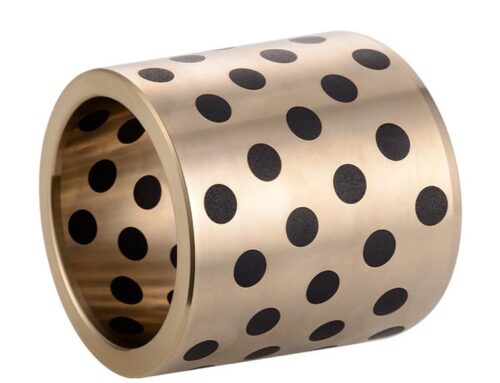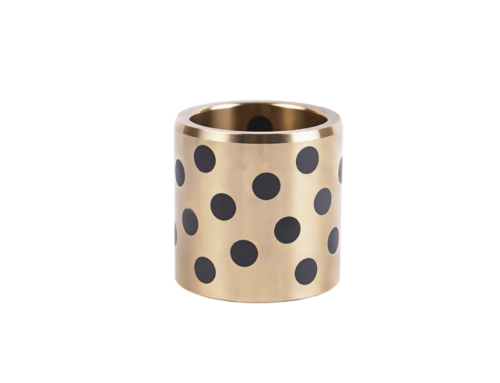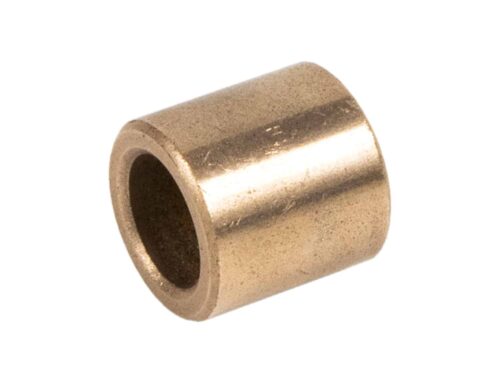Project Description
Unlocking Performance: A Deep Dive into Steel-Backed Bi-Metal Bushings
In the demanding world of mechanical engineering, bearings are the unsung heroes, enabling motion and managing friction between components. Among the various types, steel-backed bi-metal bushings (also known as bimetal bearings or sleeve bearings) stand out as a robust, versatile, and cost-effective solution for high-load, demanding applications.
But what exactly are they? Why choose them over other options? Let’s go beyond the surface and explore the construction, materials, advantages, and applications of these essential components.
What is a Steel-Backed Bi-Metal Bushing?
At its core, a bi-metal bushing is a composite bearing. It leverages the strengths of two distinct materials fused together:
-
Steel Backing: Typically made from high-quality low-carbon steel, this layer provides the structural integrity, rigidity, and press-fit capability. It forms the outer shell of the bushing, ensuring dimensional stability and allowing for secure installation into a housing. The steel backing can often be copper-plated or tin-plated for enhanced corrosion resistance, especially in challenging environments.
-
Bronze Alloy Sliding Layer: Metallurgically bonded to the inside of the steel backing is a layer of a specific bronze alloy. This is the functional sliding surface. Bronze offers excellent wear resistance, good thermal conductivity (to dissipate heat generated by friction), and embeddability (the ability to absorb small contaminant particles, protecting the shaft).
Think of it like reinforced concrete: the steel provides the tensile strength, while the bronze provides the functional surface layer optimized for sliding contact. This synergy creates a bearing that is stronger and more dimensionally stable than a solid bronze bushing, yet offers superior tribological properties (friction, wear, lubrication) compared to a simple steel-on-steel contact.
Why Choose Bi-Metal Bushings? The Advantages Explained
Bi-metal bushings offer a compelling set of features that make them suitable for a wide range of tough jobs:
-
High Load Capacity: The steel backing provides exceptional support, allowing these bushings to handle significant static and dynamic loads. Specific load capacities can reach up to 250 N/mm² (static) and 140 N/mm² (dynamic). This makes them ideal for applications experiencing heavy forces and impacts.
-
Excellent Wear Resistance & Durability: The bronze sliding layer is specifically chosen for its anti-friction and wear-resistant properties, ensuring a long service life even under demanding conditions like oscillating motion or rough operation.
-
Good Temperature Resistance: Depending on the specific bronze alloy used, bi-metal bushings can operate reliably across a wide temperature range (e.g., -40°C to +250°C or higher for certain alloys).
-
Effective Lubrication Management: While not always fully self-lubricating, bi-metal bushings are designed for efficient grease or oil lubrication. They often feature:
-
Lubrication Pockets/Indents: Machined dimples or patterns on the bronze surface act as reservoirs, holding grease or oil where it’s needed most – at the sliding interface. This ensures lubrication is maintained between maintenance intervals.
-
Grooves: Machined grooves (axial, circumferential, or figure-8) help distribute the lubricant across the bearing surface and can also help flush out debris.
-
-
Fatigue Strength: The combination of materials provides excellent fatigue strength, particularly important in applications with cyclical loading or high temperatures.
-
Cost-Effectiveness: Compared to some other high-load bearing types (like roller bearings or specialized polymer bearings), bi-metal bushings often offer a very competitive price point for their performance capabilities.
-
Versatility: Available in various forms (cylindrical bushes, flanged bushes, thrust washers, sliding plates) and customizable designs.
Contrast Logic: Bi-Metal vs. Solid Bronze vs. Sintered Bronze
| Feature | Steel-Backed Bi-Metal | Solid Bronze (Cast/Machined) | Sintered Bronze (Self-Lubricating) |
| Load Capacity | Very High (Steel Support) | Moderate to High | Low to Moderate |
| Wall Thickness | Thin (Space Saving) | Thicker | Relatively Thick |
| Cost | Moderate | Higher (Material Volume) | Low to Moderate |
| Installation | Press-Fit (Rigid) | Press-Fit or Loose | Press-Fit |
| Impact Resistance | Excellent | Good | Fair |
| Self-Lubrication | Requires Grease/Oil (Pockets help) | Requires Grease/Oil | Yes (Oil Impregnated Pores) |
| Typical Speed | Low to Medium | Low to Medium | Low to High (Light Loads) |
| Conformability | Moderate | Good | Good |
This comparison highlights that steel-backed bi-metal bushings excel where high load capacity, structural rigidity, and good wear resistance under lubrication are paramount, often in a more compact and cost-effective package than solid bronze for the same load.
Delving Deeper: The Importance of the Bronze Alloy
The “bronze” layer isn’t just one material. Different copper alloys are used to tailor the bearing’s performance to specific needs. Common alloys include:
-
CuPb10Sn10: A widely used leaded tin bronze. Offers a good balance of wear resistance, embeddability (due to lead), and load capacity. Often seen in engine components.
-
CuPb24Sn4: Higher lead content provides better embeddability and conformability, suitable for slightly misaligned shafts or where dirt ingress is possible, but with lower load capacity.
-
CuPb30: Very high lead content, excellent for conformability and seizure resistance but has the lowest load capacity and temperature resistance of the leaded bronzes.
-
CuSn6Zn6Pb3 (SAE 799): Another common leaded bronze alloy.
-
AlSn20Cu: An aluminum-tin alloy, often used in engine bearings as an alternative to leaded bronzes, offering good fatigue strength.
-
Lead-Free Options: Increasingly important due to environmental regulations (like RoHS), alloys like CuSn8Ni or CuSn6.5P0.1 offer good performance without lead.
Comparing Common Bi-Metal Bronze Alloys:
| Material Identifier | Bronze Specification | Hardness (HB) | Allowable Max Dynamic Load (Approx. N/mm²) | Max. Temp (°C) | Key Characteristics |
| Bi-Metal-800 | CuPb10Sn10 / CuSn6Zn6Pb3 | 70-100 | ~65 | 260 | General purpose, good balance of properties, engine use |
| Bi-Metal-720 | CuPb24Sn4 | 45-70 | ~38 | 200 | Higher embeddability, good conformability |
| Bi-Metal-700 | CuPb30 | 30-45 | ~25 | 170 | Excellent conformability, seizure resistance |
| Bi-Metal-20 | AlSn20Cu | 30-40 | ~30 | 150 | Good fatigue strength, common in engine bearings |
| Bi-Metal-930 | CuSn6.5P0.1 | 60-90 | ~65 | 200 | Lead-free option, good wear resistance |
(Note: Values are typical and can vary based on specific manufacturing processes.)
Choosing the right alloy depends critically on the operating load, speed, temperature, lubrication conditions, and potential for misalignment or contamination.
Technical Specifications & Design Considerations
Beyond the basic materials, understanding the technical specifications is crucial:
-
PV Value: The product of Pressure (P) and Velocity (V) is a critical limit (Max. PV ≈ 2.8 N/mm² x m/s for CuPb10Sn10). Exceeding this can lead to rapid overheating and failure.
-
Sliding Speed: Typically limited to around 2.5 m/s.
-
Friction Coefficient (µ): Generally ranges from 0.04 to 0.12 under lubricated conditions.
-
Tolerances: Precision matters. Standard recommendations often include:
-
Housing Bore: H7
-
Shaft Diameter: f7 to h8
-
Bushing Inner Diameter (after mounting): H9 (The press-fitting slightly reduces the ID)
-
-
Shaft Requirements: For optimal performance, the mating shaft should ideally be steel (hardened or unhardened) with a surface roughness (Ra) ≤ 0.8 µm. A smooth, properly toleranced shaft minimizes wear.
Where Do Bi-Metal Bushings Shine? Applications
Their robustness makes bi-metal bushings ideal for demanding applications, including:
-
Construction Machinery: Track rollers, idler wheels, pivot points on excavators, bulldozers, cranes.
-
Agricultural Machinery: Linkages, pivot points, suspension components on tractors and implements (often subject to shock loads).
-
Heavy-Duty Trucks: Kingpins, suspension systems (e.g., balance suspensions), chassis components.
-
Automotive: Connecting rod bearings (especially in older or heavy-duty engines), chassis components.
-
Industrial Equipment: Gearboxes, hydraulic cylinder pivots, general machinery requiring high load capacity.
Installation & Maintenance: Getting it Right
While durable, proper installation and maintenance are key to longevity:
-
Cleanliness: Ensure the housing bore and bushing exterior are clean.
-
Alignment: Ensure the bushing is aligned correctly with the housing bore.
-
Press-Fitting: Use an appropriate mounting mandrel that applies force evenly to the bushing’s end face. Never hammer directly on the bearing. Applying a light lubricant to the bushing outer diameter can ease installation. Ensure the housing has a lead-in chamfer (min. 1.5 mm x 15-45°).
-
Shaft Insertion: The shaft should have a lead-in chamfer (e.g., 5 mm x 15°) with rounded edges to avoid damaging the bronze layer during assembly.
-
Initial Lubrication: Crucial! Bi-metal bearings require initial greasing upon installation. Pack the bearing and surrounding area with a suitable grease (consult manufacturer recommendations).
-
Periodic Lubrication: These are low-maintenance, not no-maintenance. Regular re-greasing intervals (based on operating conditions) are mandatory to replenish lubricant and flush out contaminants. Oil lubrication systems are also applicable.
Finding the Right Supplier & Solution
Choosing a reliable supplier (like bronzelube.com, mentioned in the source material) is vital. Look for manufacturers who:
-
Offer a range of standard metric and imperial sizes.
-
Provide high-quality materials and consistent manufacturing (tested and proven).
-
Offer customization services (special dimensions, flanges, grooves, material variations).
-
Maintain reasonable minimum order quantities (MOQ) and offer fast delivery.
-
Provide technical support to help select the right bearing for your application.
-
Offer competitive pricing to help manage project budgets.
Conclusion
Steel-backed bi-metal bushings represent a powerful combination of strength, wear resistance, and cost-effectiveness. Their layered structure, leveraging the rigidity of steel and the tribological excellence of bronze alloys, makes them a go-to solution for high-load, moderate-speed applications across various industries. By understanding the different material options, design features, and proper installation/maintenance procedures, engineers and designers can effectively utilize these reliable components to ensure long-lasting performance in demanding mechanical systems.
Whether you need standard cylindrical bushes, flanged bearings, or custom-designed parts, exploring the possibilities offered by bi-metal technology can lead to robust and efficient engineering solutions.





